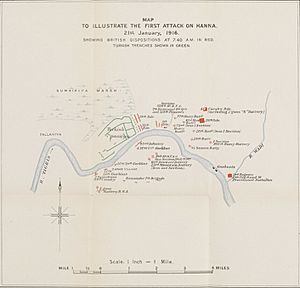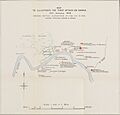Battle of Hanna facts for kids
Quick facts for kids First Battle of Hanna |
|||||||
|---|---|---|---|---|---|---|---|
| Part of the Mesopotamian Campaign of World War I | |||||||
 A 1924 British map showing the first attack on Hanna. |
|||||||
|
|||||||
| Belligerents | |||||||
|
|||||||
| Commanders and leaders | |||||||
|
|
|||||||
| Strength | |||||||
| 10,000 men (remnants of 2 divisions) | 30,000 men | ||||||
| Casualties and losses | |||||||
| 2,741 casualties | 503 casualties | ||||||
The First Battle of Hanna was an important fight during World War I. It happened on January 21, 1916, between the Ottoman and British-Indian armies. This battle took place in a region called Mesopotamia, which is modern-day Iraq.
Contents
Why the Battle Happened
Britain's Goals in Mesopotamia
When the Ottoman Empire joined World War I, Britain became worried. They wanted to protect their oil interests in the Persian Gulf. So, Britain sent a group of soldiers called the Indian Expeditionary Force D. Their first job was to take control of the Shatt al Arab river and the city of Basra.
Over time, the British-Indian force's goal changed. They decided to try and capture the important city of Baghdad. They won some battles along the way, like at Qurna and Nasiryeh.
The Retreat to Kut-al-Amara
After a tough battle near Ctesiphon, the main British-Indian force had to pull back. The Ottoman soldiers, who were now stronger, chased them. The British-Indian troops ended up in a town called Kut-al-Amara. This town was in a good spot, where two rivers met. The British commander decided to defend the town.
The Siege of Kut
Around 10,000 British-Indian soldiers were surrounded by Ottoman troops. This happened on December 15, 1915. The British commander, Major General Charles Townshend, asked for help.
The British commander in Mesopotamia, General Sir John Nixon, started putting together a relief force. This force, called the Tigris Corps, had about 19,000 men. Their mission was to break through the Ottoman lines and rescue the soldiers trapped in Kut.
The Relief Force's Journey
The relief force was led by Lieutenant General Fenton Aylmer. They faced difficulties early in their mission. After some defeats, their numbers dropped to about 10,000 men.
Despite these problems, they were ordered to try again. They moved along the Tigris River. Soon, they met a large Ottoman army of 30,000 men. This Ottoman force was led by Khalil Pasha. The two armies met at a narrow place called the Hanna defile, about 30 miles from Kut-al-Amara.
The Battle of Hanna
The battle began after a short bombing attack on January 20 and 21, 1916. The British 7th Division then charged forward. They had to cross about 600 yards of flooded land.
The Ottoman positions were very strong. They had machine guns placed in good spots. The British soldiers suffered many losses, with about 2,700 casualties. Because of the heavy fighting and losses, the British had to stop their attack. They pulled back their relief force.
What Happened Next
After the Attack
After the battle, medical help was very hard to find. The night was freezing cold. Many wounded British soldiers suffered a lot because of this. The soldiers' spirits dropped very low.
The trapped soldiers in Kut-al-Amara could hear the distant sounds of the battle. When the relief force didn't reach them, their spirits also fell.
The End of the Siege
The British tried two more times to rescue the soldiers in Kut-al-Amara. However, these attempts also failed. The soldiers trapped in Kut-al-Amara were eventually forced to give up. They surrendered to the Ottoman forces on April 29, 1916. This event is known as the Siege of Kut.
Images for kids


